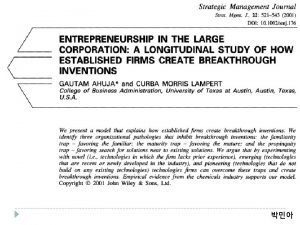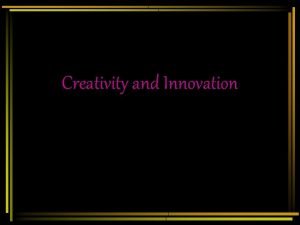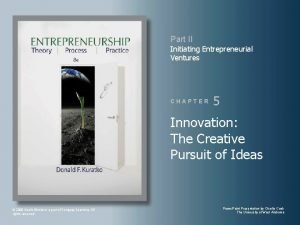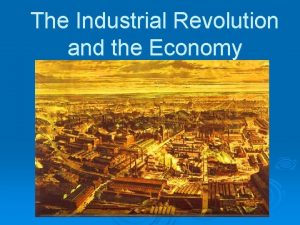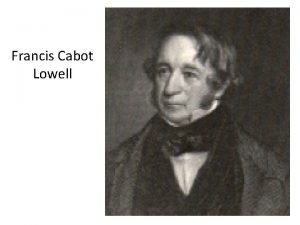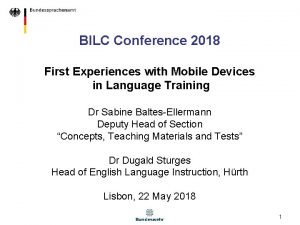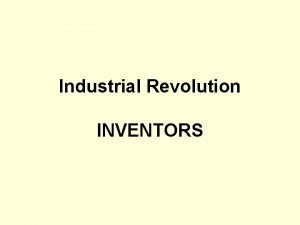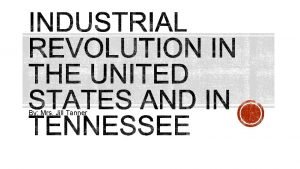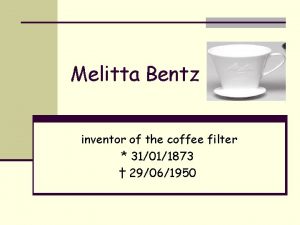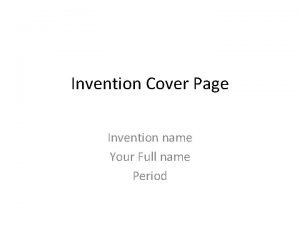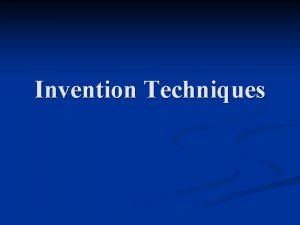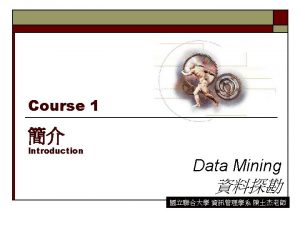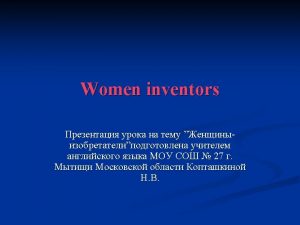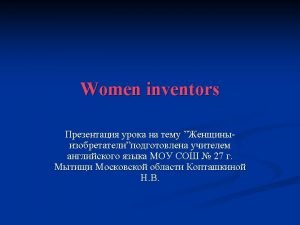What is an Invention An invention is a











- Slides: 11

What is an Invention An invention is a unique or novel device, method, composition or process. It may be an improvement upon a machine or product, or a new process for creating an object or a result. An invention that achieves a completely unique function or result may be a radical breakthrough. Such works are novel and not obvious to others skilled in the same field. The person of ordinary skill in the art is a legal fiction found in many patent laws throughout the world. This fictional person is considered to have the normal skills and knowledge in a particular technical field. The inventive step and non-obviousness reflect a same general patentability requirement present in most patent laws, according to which an invention should be sufficiently inventive — i. e. , non-obvious — in order to be patented. In other words, "nonobviousness principle” asks whether the invention is an adequate distance beyond or above the state of the art.

Who is an Inventor In patent law, an inventor is the person, or persons in United States patent law, who contribute to the claims of a patentable invention. "Joint inventors", or "co-inventors", exist when a patentable invention is the result of inventive work of more than one inventor. Joint inventors exist even where one inventor contributed a majority of the work. An inventor is a party who has contributed at least one claim to a patent. The threshold question" of inventorship is "who conceived the invention. " Courts recognize that invention is rarely a solitary endeavor. Therefore, conception and "intellectual domination" over an invention is important and "reduction to practice, per se, is irrelevant. One must contribute to the conception to be an inventor. Generally, conception is "the complete performance of the mental part of the inventive act", and "the formation in the mind of the inventor of a definite and permanent idea of the complete and operative invention as it is thereafter to be applied in practice. " An idea is usually not "definite and permanent" or "complete" where changes result from experimentation. In this case, other individuals who contribute to the formation of the "definite and permanent" idea are co-inventors.

Authors vs. Inventors Authors 2 of these 3 Conception Inventors Execution Analysis

The Disclosure Process at Notre Dame • Fully disclose all aspects of the invention, highlight the novel and non-obvious features of the invention. • Technically describe the invention. Identify it as a process, machine, manufacture, or composition of matter or as an improvement thereof. • List possible variation and modifications within the scope of the invention. • Cite examples of different embodiments of the invention. • Emphasize the best mode of employing the invention. • Disclose the invention completely so that others of ordinary skill in the art could replicate the invention. • Describe the invention in terms of competing technologies.


Provisional Patents A provisional application for patent is a type of patent application filed with the US Patent and Trademark Office that does not mature into an issued patent unless a non-provisional patent application (usually a utility patent application) is filed by the applicant within one year. Provisional applications require only a specification (complete written description) of the invention for filing, and can thus provide a relatively quick and inexpensive means of establishing an early filing date with the USPTO. Provisional patent applications lapse one year after the filing date and the benefit of the early filing date is lost if the application is not converted into a non-provisional (e. g. – utility) application. Provisional patent applications (PPAs) are inexpensive to file – the filing fee is just over $100. The cost of a US utility patent, from application through prosecution to issuance, can be $30, 000 or more, depending on the complexity and scope of the application and the actions taken by, and in response to, the patent office. The cost for worldwide patent coverage can be many times greater.

Licensing A licensor may grant a license under intellectual property laws to authorize a use (such as copying software or using a (patented) invention) to a licensee, sparing the licensee from a claim of infringement brought by the licensor. A license under intellectual property commonly has several components beyond the grant itself, including a term, territory, renewal provisions, and other limitations deemed vital to the licensor.

Royalties Of the first $100, 000 of net income: 50% to the creator 50% to the general fund of the University For all net income over $100, 000 but less than $1, 000: 25% to the creator 25% to a research account to promote the creator’s continued research at the University, provided the creator is a full-time member of the research faculty or the teaching and research faculty. If the creator is not or ceases to be a full-time member of the research faculty or the teaching and research faculty, these funds will be directed to the creator’s department to promote department research. 25% to the department of the creator to promote research 25% to the general fund of the University For all net income exceeding $1, 000: 25% to the creator 15% to the department of the creator to promote research 10% to the college of the creator to promote research 50% to the general fund of the University

America Invents Act First to File: Billed as the most significant change to U. S. patent law, under the new law if two inventors independently create the same invention, the first to file a patent application will get the patent, regardless of which one was the first inventor. One exception to this rule is that if an inventor publishes details about the invention and then files a patent application within one year of the publication, that inventor will receive priority over other patent applications that are filed after the publication date. Because of this, the U. S. “first to file” system may be more appropriately called “first to file or publish. ” Expanded Definition of “Prior Art”: Unlike the previous law which provided certain exceptions foreign disclosures and U. S. publications made within one year of a patent filing, under the new law any third party publication made before a patent application’s filing date may be considered to be prior art. These provisions go into effect 16 March 2013


Bayh-Dole Act Small businesses and non-profit organizations can retain the title in a federally funded "subject invention. " In exchange, the organization is required to • Report each disclosed invention to the funding agency • Elect to retain title in writing within a statutorily prescribed timeframe • File for patent protection • Grant the federal government a non-exclusive, non-transferable, irrevocable, paid-up license to practice or have practiced on its behalf throughout the world • Actively promote and attempt to commercialize the invention • Not assign the rights to the technology, with a few exceptions • Share royalties with the inventor • Use any remaining income for education and research • Give preference to U. S. industry and small business (including university startups)
 Breakthrough invention
Breakthrough invention Creativity innovation and invention
Creativity innovation and invention Eliminating muddling mindset
Eliminating muddling mindset Jethro tull invention
Jethro tull invention Francis cabot lowell invention
Francis cabot lowell invention Melitta bentz invention
Melitta bentz invention John w. reed inventor
John w. reed inventor John kay invention
John kay invention Invention design and development
Invention design and development Samuel slater invention
Samuel slater invention Melitta bentz
Melitta bentz Mikhail tsvet chromatography experiment
Mikhail tsvet chromatography experiment
